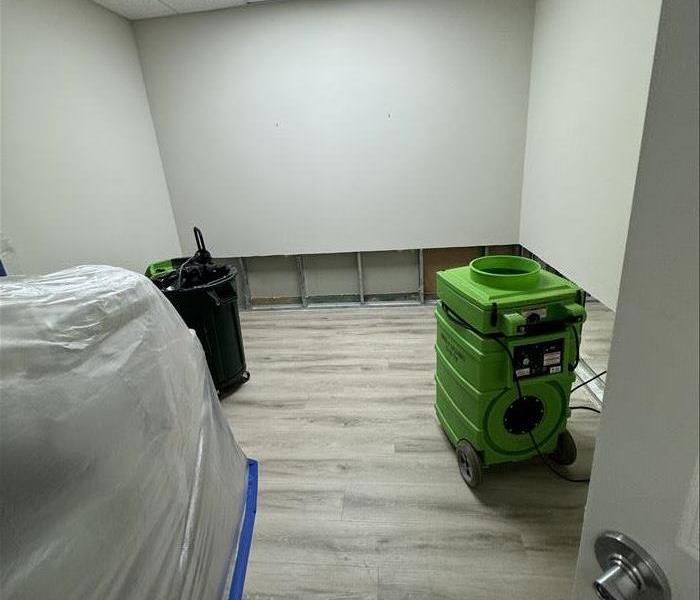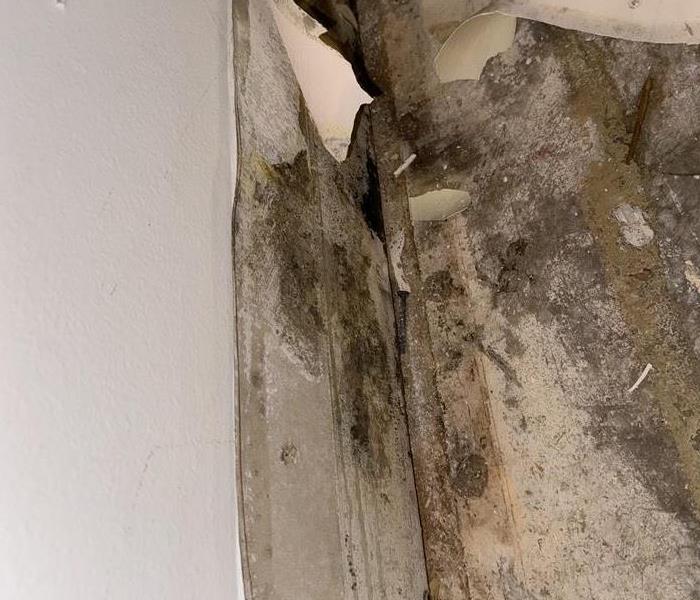Recent Posts
The Advantages of Hiring Professionals for Fire Damage Restoration
12/12/2024 (Permalink)
Fire damage is one of the most devastating events a home or business owner can face. Not only does it destroy property, but it also leaves behind lingering issues like smoke damage, soot, and structural instability. While it may be tempting to attempt cleanup on your own, fire damage restoration is a complex process that requires expertise and specialized equipment. Hiring professionals for fire damage restoration offers several key benefits that ensure a thorough, safe, and efficient recovery process.
1. Expert Assessment and Action Plan
One of the most important benefits of hiring fire damage restoration professionals is their ability to thoroughly assess the damage. Fires affect structures in unpredictable ways, causing damage that might not be immediately visible. Professionals are trained to look for hidden issues, such as structural weakness, electrical damage, or moisture buildup from firefighting efforts, which could lead to mold growth if left unchecked.
Once the assessment is complete, the restoration team develops a comprehensive action plan. This plan outlines the steps required to restore the property, from debris removal to smoke odor elimination and structural repairs. Having a clear, expert-driven process ensures that nothing is overlooked, allowing for a more efficient and thorough restoration.
2. Advanced Equipment and Techniques
Professional fire damage restoration companies like SERVPRO® use specialized equipment that isn’t typically available to the average homeowner. High-powered air scrubbers, industrial-grade dehumidifiers, ozone generators, and thermal fogging machines are just a few examples of the tools used to clean, deodorize, and restore a fire-damaged property.
These advanced tools are essential for removing soot and smoke particles from the air and surfaces, reducing the risk of secondary damage. Without the right equipment, DIY attempts can leave behind dangerous residues or cause further damage. Professional teams also use advanced techniques for restoring items like furniture, appliances, and personal belongings, which might otherwise be lost in a DIY cleanup.
3. Faster Restoration Process
Time is of the essence when dealing with fire damage. The longer the damage sits untreated, the worse it can become, with soot and smoke continuing to damage surfaces, and water from firefighting efforts leading to mold and corrosion. Fire damage restoration professionals work quickly to mitigate these effects.
With a dedicated team, multiple areas of your home or business can be worked on simultaneously. Professionals have the manpower and experience to handle large-scale cleanups efficiently, which means you can return to normal life or business operations much sooner.
4. Safe Cleanup and Hazard Management
Cleaning up after a fire is dangerous. The air is often filled with hazardous chemicals, soot, and ash, which can pose significant health risks without the proper safety gear. In addition, fire-damaged structures can be unstable, with weakened walls, ceilings, and floors that could collapse without warning.
Professional restoration companies are trained to handle these dangers safely. They have the personal protective equipment (PPE) and knowledge needed to work in hazardous environments and stabilize the property before starting the cleanup process.
5. Insurance Assistance
Navigating insurance claims after a fire can be overwhelming. Fire damage restoration professionals often work closely with insurance companies, providing detailed documentation of the damage and restoration process. This can speed up the claims process and ensure you receive fair compensation for your losses.
Hiring professionals for fire damage restoration ensures that the process is handled quickly, safely, and thoroughly. With expert assessment, advanced tools, and experience, companies like SERVPRO of Cape Coral can help you restore your property and belongings, minimize long-term damage, and support you through the insurance process. By entrusting your restoration to professionals, you’ll be on the fastest path to recovery, with peace of mind that your home or business is in good hands.
How Mold Spreads: Understanding the Process and How SERVPRO® Can Help
11/12/2024 (Permalink)
Mold is a common issue that homeowners and businesses often face, especially in areas with high humidity or where water damage has occurred. Understanding how mold spreads is crucial in preventing and mitigating its impact on property. Once mold begins growing in a space, it can spread rapidly and cause extensive damage if not addressed. Here’s how mold spreads and how SERVPRO of Cape Coral can help with expert mold remediation services.
Mold Growth Basics
Mold is a type of fungus that thrives in damp, humid environments. It reproduces by releasing microscopic spores into the air. These spores are lightweight, making them easy to travel through the air and land on various surfaces. Once the spores land in a new location with favorable conditions—such as moisture, warmth, and organic material to feed on—they can begin growing and forming new mold colonies.
The Role of Moisture
The primary factor that enables mold growth and spread is moisture. Mold spores are always present in both indoor and outdoor environments, but they only become a problem when they find damp areas to settle. This is why water damage, leaks, or high humidity levels often result in mold problems. Common sources of moisture include leaking pipes, roof leaks, floods, or even condensation from poor ventilation.
When mold spores find moisture, they start growing within 24 to 48 hours. Mold can grow on wood, drywall, carpeting, and even insulation, making it a serious concern for property owners. The key to preventing mold spread is controlling moisture levels in your home or business.
Airborne Spores
Once mold establishes itself, it continues to release spores into the air, which can then travel throughout your property. Air currents, HVAC systems, and even foot traffic can help spread mold spores to different rooms or areas. This airborne nature makes mold difficult to contain without proper intervention.
Surface Contamination
Mold doesn’t just spread through the air—it can also spread by direct contact. If mold grows on a surface, it can release spores into the immediate area or onto neighboring surfaces. For example, if mold grows on a wall, it can spread to furniture, flooring, or other materials that are in close proximity.
How SERVPRO® Can Help
When dealing with mold, it’s essential to call professionals like SERVPRO. Mold remediation is not just about cleaning visible mold but also about addressing the underlying moisture issue to prevent further spread. SERVPRO’s trained technicians use advanced equipment to detect moisture, remove mold colonies, and purify the air. Additionally, they’ll take steps to ensure that mold spores don’t continue to spread through the air or on surfaces.
With SERVPRO’s expert mold remediation services, you can be confident that your home or business will be restored to a clean, safe environment. Prevention and quick action are key, so if you suspect mold growth, don’t hesitate to reach out to SERVPRO of Cape Coral for immediate assistance.
How Landscaping Can Prevent Basement Flooding: A Guide for Homeowners
10/16/2024 (Permalink)
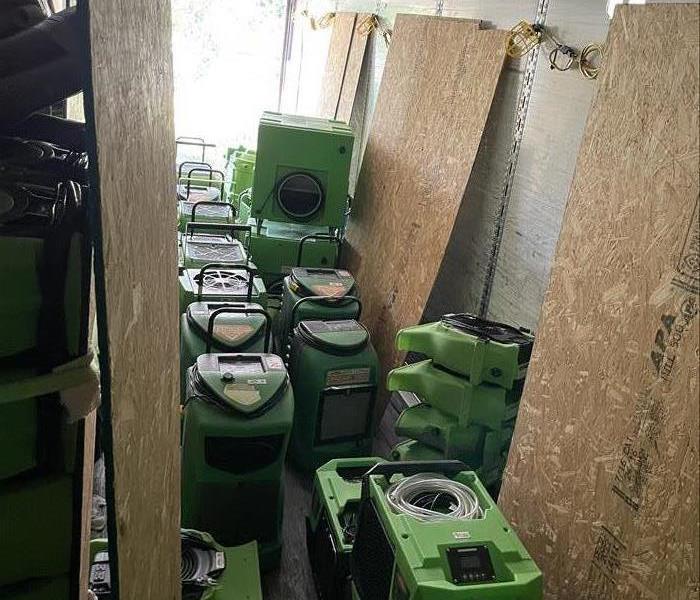 This blog will explore how strategic landscaping can protect your home from basement flooding.
This blog will explore how strategic landscaping can protect your home from basement flooding.
Basement flooding is a homeowner's nightmare, causing thousands of dollars in damage and leading to long-term structural issues. In fact, nearly 98 percent of basements will experience some form of water damage during their lifespan. Proper landscaping can be one of the most effective measures to prevent basement flooding. While most people associate landscaping with aesthetics, its role in water management is crucial. This blog will explore how strategic landscaping can protect your home from basement flooding.
How Landscaping Prevents Basement Flooding
Landscaping is more than just planting trees and flowers. It involves designing your outdoor space to manage water runoff effectively, preventing it from entering your home. Here’s how:
1. Proper Grading and Sloping
One of the most important elements of flood prevention through landscaping is proper grading. Grading refers to the slope of your yard, which should direct water away from your home’s foundation. If your yard slopes toward your home, rainwater and melting snow can accumulate around the foundation, eventually seeping into your basement.
A well-executed landscape grading plan should ensure that all water flows away from your home. Ideally, the soil should slope at least six inches over a 10-foot distance away from the house. Consulting with a professional landscaper can ensure the grading is done correctly.
2. French Drains and Dry Wells
Installing French drains is another effective landscaping solution. A French drain is a trench filled with gravel or rock containing a perforated pipe that redirects surface water and groundwater away from the home. By integrating French drains into your landscaping design, you can significantly reduce the risk of basement flooding.
Dry wells are another option, especially in areas where water tends to accumulate. These underground structures collect excess rainwater and allow it to slowly seep into the ground, preventing water buildup near your foundation.
3. Using Native Plants for Water Absorption
Plants play a vital role in water management. Native plants, in particular, are excellent at absorbing rainwater due to their deep root systems. These plants can help reduce runoff by soaking up excess water that would otherwise flow toward your home’s foundation.
When choosing plants for your yard, consider varieties that are well-suited to your local climate. Native plants require less water and maintenance, and they are better equipped to handle your area's specific rainfall patterns.
4. Rain Gardens for Stormwater Control
A rain garden is a landscaped area designed to collect and absorb rainwater runoff from roofs, driveways, and other hard surfaces. It’s essentially a shallow depression that’s filled with plants, mulch, and soil that work together to absorb water.
Rain gardens not only add beauty to your landscape but also help manage stormwater by reducing runoff and allowing the water to naturally filter into the ground. By preventing water from pooling near your home, you minimize the risk of basement flooding.
5. Maintaining Gutters and Downspouts
While it may not seem like a part of your landscape, your gutters and downspouts are essential in directing water away from your home. Ensuring your gutters are clean and that downspouts extend at least five to ten feet away from your foundation is crucial in preventing water from pooling around your home.
Consider adding splash blocks or extending the downspouts further if needed. These simple yet effective landscaping solutions can prevent a basement flood.
Importance of Professional Landscaping for Flood Prevention
While some landscaping tasks can be DIY, preventing basement flooding requires a well-thought-out plan that considers your entire property’s drainage. Working with a professional landscaping service ensures that grading, drainage solutions, and plant selection are optimized to protect your home. A professional will assess your property’s unique needs and design a landscaping plan that effectively manages water and prevents flooding.
Conclusion
Investing in the right landscaping solutions can save you from the financial and emotional stress of a flooded basement. Proper grading, the installation of French drains, rain gardens, and using native plants are all effective strategies that help redirect water away from your home. By working with landscaping professionals, you can create a yard that is not only beautiful but also functional in protecting your home from water damage.
Take the necessary steps today to safeguard your basement, and let landscaping be part of your flood prevention strategy.
Preparing Your HVAC System for Storm Season
9/11/2024 (Permalink)
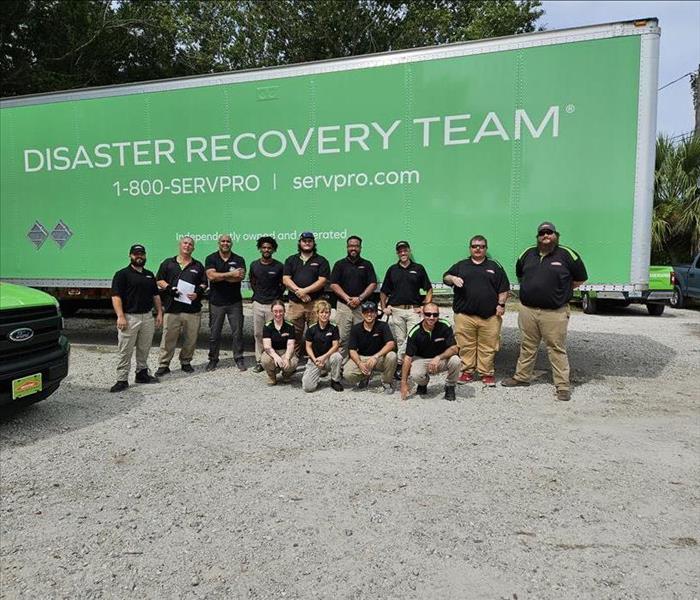 If you need assistance with HVAC maintenance or any other storm preparation services, don’t hesitate to reach out to our team of experts.
If you need assistance with HVAC maintenance or any other storm preparation services, don’t hesitate to reach out to our team of experts.
As storm season approaches, ensuring your home is well-prepared is crucial. One often overlooked aspect is the HVAC system, which plays a vital role in maintaining comfort and safety during severe weather. At SERVPRO®, we understand the importance of having a well-maintained HVAC system, especially when storms are on the horizon. Here are some essential tips for preparing your HVAC system for storm season, ensuring it remains functional and efficient when you need it most.
Professional Inspection
First, schedule a professional HVAC inspection. Regular maintenance checks are essential for identifying potential issues before they become significant problems. A professional technician will inspect your system, clean the components, and ensure everything functions correctly. This preventive measure can save you from costly repairs and ensure your HVAC system is ready to handle any storm.
Air Filters
Next, check and replace air filters. Clean air filters are crucial for optimal performance. Clogged or dirty filters can reduce efficiency and strain your HVAC system, leading to potential breakdowns. During storm season, your system may need to work harder to maintain a comfortable indoor environment, making it even more critical to have clean filters. Replacing them every one to three months is a good rule of thumb, depending on usage and the type of filter you use.
Outdoor Unit
Protecting your outdoor unit is another essential step. Storms can bring heavy winds, rain, and debris, all of which can damage your HVAC system’s outdoor components. Ensure the area around your unit is clear of loose objects that could become projectiles during a storm. Installing a protective cover or fence around your unit can also help shield it from flying debris. Additionally, consider securing the unit to its base to prevent it from being toppled by strong winds.
Surge Protector
It’s also wise to install a surge protector for your HVAC system. Storms often bring power surges that can damage electrical components within your HVAC system. A surge protector can safeguard your system from these sudden spikes in voltage, ensuring it continues to operate smoothly. This small investment can significantly extend the lifespan of your HVAC system and protect you from unexpected repair costs.
Proper Drainage
Another important aspect of storm preparation is ensuring proper drainage around your HVAC system. Heavy rainfall can lead to water pooling around your outdoor unit, which can cause significant damage. Make sure the ground around your unit slopes away to prevent water accumulation. Additionally, clear any debris from the drainage lines to ensure water can flow freely away from your system.
Power Outages
Lastly, have a plan for power outages. Storms can often lead to power loss, which can affect your HVAC system’s operation. Consider investing in a backup generator to keep your system running during outages. If a generator isn’t an option, have an alternative plan to maintain comfort, such as battery-operated fans or temporary shelter arrangements.
At SERVPRO, we are dedicated to helping you prepare for storm season. By taking these proactive steps to ready your HVAC system, you can ensure it remains reliable and efficient, providing you with peace of mind during the stormy months ahead. If you need assistance with HVAC maintenance or any other storm preparation services, don’t hesitate to reach out to our team of experts. We’re here to help you weather the storm safely and comfortably.
How Accurate Are Air Mold Tests?
7/17/2024 (Permalink)
At SERVPRO®, we understand that mold can be a major concern for homeowners and business owners alike. One common method to identify mold presence is through air mold tests. But how accurate are these tests, and can they truly provide reliable results? In this blog, we’ll dive into the intricacies of air mold testing and explore its accuracy.
Understanding Air Mold Tests
Air mold tests involve collecting samples of air from your home or business and analyzing them for mold spores. These tests are typically conducted using spore traps or air sampling pumps that capture airborne particles on a sticky surface or in a liquid medium. The samples are then sent to a laboratory where they are examined under a microscope to identify and quantify mold spores.
Factors Affecting Accuracy
Several factors can influence the accuracy of air mold tests:
- Sampling Location: The location where air samples are collected plays a crucial role. Sampling in areas with visible mold growth or water damage will likely yield higher mold spore counts. Conversely, sampling in clean, undisturbed areas may not provide an accurate representation of the overall mold presence.
- Timing and Conditions: Mold spore levels can fluctuate based on environmental conditions such as humidity, temperature, and airflow. Sampling during different times of the day or under varying weather conditions can affect the results. For example, high humidity levels can increase mold spore counts in the air.
- Duration of Sampling: The duration for which air samples are collected also impacts accuracy. Longer sampling times can provide a more comprehensive picture of mold spore levels, while shorter sampling durations might miss transient spikes in mold spore concentrations.
- Equipment Calibration and Handling: The precision and calibration of the sampling equipment, as well as how the samples are handled and stored, can influence the test outcomes. Improper handling or equipment malfunction can lead to inaccurate results.
Interpretation of Results
Interpreting the results of air mold tests can be challenging. Mold spores are a natural part of the environment, and their presence in air samples does not always indicate a problem. It’s essential to compare indoor mold spore levels with outdoor levels to determine if there is an unusual indoor mold growth. Additionally, identifying the types of mold spores present can help determine the source and potential severity of the issue.
Combining Methods for Better Accuracy
While air mold tests can provide valuable insights, they are most effective when combined with other inspection methods. Visual inspections, moisture assessments, and surface sampling can complement air testing to provide a more comprehensive understanding of mold presence and sources. At SERVPRO, our trained professionals use a combination of these methods to deliver accurate and reliable mold assessments.
Air mold tests are a useful tool in detecting and assessing mold levels in indoor environments. However, their accuracy can be influenced by various factors, and results should be interpreted with caution. Combining air testing with other inspection techniques can enhance the reliability of mold assessments. If you suspect mold in your home or business, contact SERVPRO for a thorough and professional mold inspection and remediation service.
For more information on mold testing and remediation, visit our website or call us today. At SERVPRO, we are Here to Help® you maintain a safe and clean environment.
The impact of fire damage on flooring and carpets
7/10/2024 (Permalink)
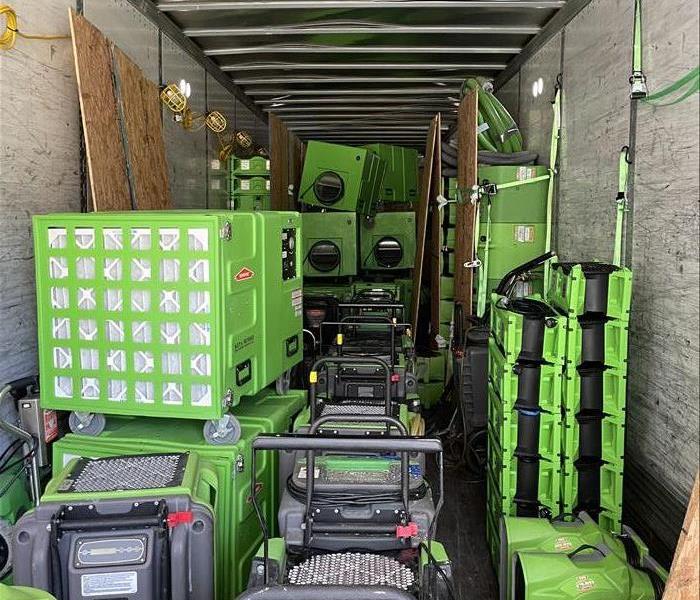 At SERVPRO, we have the experience and expertise to handle these challenges, providing peace of mind during a difficult time.
At SERVPRO, we have the experience and expertise to handle these challenges, providing peace of mind during a difficult time.
When a fire strikes, the immediate concern is often the visible structural damage and the loss of personal belongings. However, the impact of fire damage on flooring and carpets is a critical aspect that requires immediate attention. At SERVPRO®, we understand that addressing these hidden damages is vital for the safety and restoration of your home or business.
The Nature of Fire Damage on Flooring and Carpets
Fire damage extends beyond the flames. The heat, smoke, and soot from a fire can severely affect various flooring materials and carpets, each in unique ways.
Hardwood Flooring
Hardwood floors are particularly vulnerable to fire damage. The intense heat can cause warping, cracking, and splitting. Smoke and soot can penetrate the wood's porous surface, leading to discoloration and a lingering odor. Even if the fire did not directly touch the hardwood, the combination of heat and smoke can cause significant damage.
Carpeted Floors
Carpets suffer from fire damage in multiple ways. The fibers can melt, burn, and become deeply embedded with soot and smoke particles. Synthetic carpets are particularly susceptible to heat and can emit toxic fumes when burned. The damage isn't just surface-level; it penetrates through to the padding and subfloor, requiring comprehensive cleaning or replacement.
Tile and Stone Flooring
While tile and stone floors are more resistant to fire, they are not immune. The grout can crack and tiles may become loose due to the heat. Additionally, smoke and soot can leave a residue that is difficult to remove, affecting both the appearance and integrity of the flooring.
The Importance of Professional Restoration
Addressing fire damage to flooring and carpets involves more than just a superficial clean-up. It's a process that requires expertise, specialized equipment, and a deep understanding of fire restoration techniques.
Assessment and Inspection
The first step is a thorough assessment. Our SERVPRO professionals evaluate the extent of the damage, including areas that may not be immediately visible. This includes checking under carpets, inside floorboards, and behind tiles to ensure that all damage is identified.
Cleaning and Deodorizing
Once the assessment is complete, the cleaning process begins. For hardwood floors, this might involve sanding and refinishing to restore the wood's appearance. Carpets often require deep cleaning, which includes the removal of soot and smoke particles from the fibers and padding. Tile and stone floors are cleaned and any damaged grout or tiles are replaced.
Restoration and Replacement
In cases where the damage is too severe for cleaning, replacement may be necessary. SERVPRO works to match your existing flooring as closely as possible, ensuring a seamless restoration. Our goal is to restore your home or business to its pre-fire condition quickly and efficiently.
Trust SERVPRO for Comprehensive Fire Damage Restoration
Fire damage to flooring and carpets is a challenging aspect of recovery. It requires a keen eye for detail, advanced cleaning techniques, and the ability to restore or replace damaged materials. At SERVPRO, we have the experience and expertise to handle these challenges, providing peace of mind during a difficult time. Trust us to restore your property with care and precision.
For more information or to schedule a consultation, contact SERVPRO today. Let us help you reclaim your space and restore your flooring and carpets to their former glory.
Water Damage in Commercial Properties: Retail Spaces and Warehouses
6/12/2024 (Permalink)
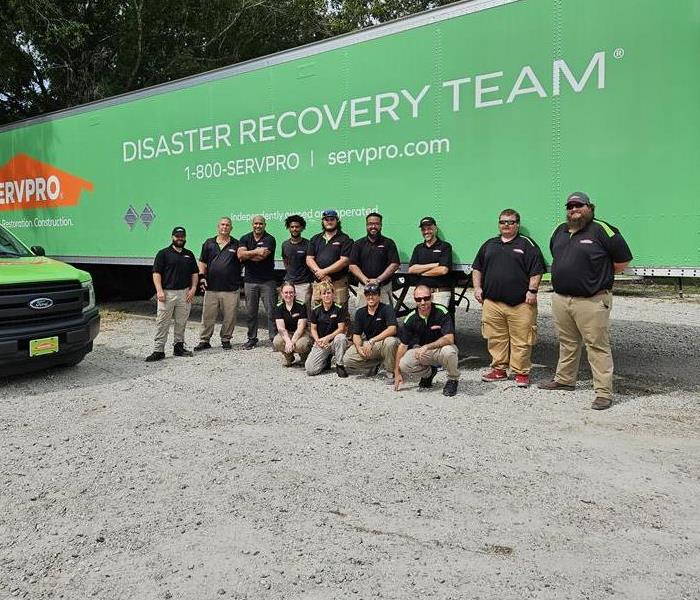 With the right knowledge and prompt action, you can minimize the downtime and get your commercial property back on track.
With the right knowledge and prompt action, you can minimize the downtime and get your commercial property back on track.
Water damage is an unfortunate incident that can occur in any commercial property, including retail spaces and warehouses. Whether it's a leaky roof, burst pipe, or flooding from heavy rain, water damage can disrupt your business operations, damage inventory, and lead to costly repairs. However, with the right knowledge and prompt action, you can minimize the downtime and get your commercial property back on track.
Identify the Source of the Water Damage
The first step in addressing water damage is to identify the source. Quickly locate and shut off the water supply to prevent further damage. In retail spaces and warehouses, common sources of water damage include roof leaks, malfunctioning plumbing systems, and weather-related incidents. By identifying the source, you can better understand the extent of the damage and take appropriate measures.
Prioritize Safety
Before entering the affected area, ensure that it is safe to do so. If there are any electrical appliances or exposed wires, turn off the power immediately to avoid the risk of electrocution. Exercise caution and consider professional assistance when dealing with extensive water damage or potential structural issues.
Contact a Professional Commercial Restoration Service
Commercial water damage requires professional expertise to ensure thorough and efficient recovery. Contact a reputable commercial restoration service like SERVPRO® as soon as possible. SERVPRO specializes in commercial water damage restoration and understands the unique challenges faced by retail spaces and warehouses. Their experienced team can help assess the damage, provide expert solutions, and restore your commercial property efficiently.
Document the Damage and Notify Insurance
Before any restoration work begins, document the water damage by taking photos and videos. This documentation will be crucial when filing an insurance claim. Notify your insurance company promptly to initiate the claims process and ensure you have all the necessary paperwork ready.
Remove Standing Water
If it is safe to do so, start the water extraction process to remove standing water from the affected areas. Utilize pumps, wet vacuums, or other appropriate equipment to remove as much water as possible. Swift removal of standing water helps minimize potential damage to structural components and reduces the risk of mold growth.
Dry and Dehumidify
After water extraction, it is vital to thoroughly dry the affected areas. Use powerful fans and dehumidifiers specifically designed for commercial spaces to accelerate the drying process. This step is critical in preventing the growth of mold and mildew, which can be damaging to inventory and affect the air quality within your commercial property.
Assess and Restore Inventory and Fixtures
Once the affected areas are dry, evaluate the condition of your inventory and fixtures. Dispose of any damaged or unsalvageable items following the guidance of your insurance provider. Clean and sanitize salvageable items to ensure they are safe for use or sale. Additionally, inspect and repair any damaged fixtures such as shelving, display units, or flooring to return your commercial property to its pre-damage condition.
Prevention is Key
To minimize the risk of future water damage, it's essential to implement preventative measures. Regularly inspect your property for any signs of leaks, roof damage, or plumbing issues. Ensure your property's drainage systems are clear and functioning correctly. Address any identified issues promptly to mitigate potential water damage risks.
In conclusion, water damage in commercial properties such as retail spaces and warehouses can have severe consequences for your business. By following these recovery and clean-up tips, along with the assistance of a professional commercial restoration service like SERVPRO, you can minimize the impact of water damage and restore your commercial property efficiently. Act promptly, document the damage, and rely on expert help to ensure a thorough and effective restoration process.
How to Handle Fallen Trees and Debris After Cape Coral Storms
5/15/2024 (Permalink)
 In this blog, we will explore important steps to take when cleaning up fallen trees and debris after storms in Cape Coral.
In this blog, we will explore important steps to take when cleaning up fallen trees and debris after storms in Cape Coral.
When severe storms hit Cape Coral, they can leave behind a trail of destruction, including fallen trees and debris. It is crucial to handle storm damage promptly and safely to minimize the risk of further property damage and ensure the safety of yourself and others. In this blog, we will explore important steps to take when cleaning up fallen trees and debris after storms in Cape Coral.
Assess the Situation and Ensure Safety
Before you begin any cleanup, assess the storm damage and ensure your safety. Be aware of downed power lines, unstable structures, and other potential hazards. It is essential to stay away from any electrical wires and contact the appropriate authorities to report the issue. If you are uncertain about the safety of the area, it is best to wait for professional assistance.
Contact Professional Storm Cleanup Services
Dealing with fallen trees and large amounts of debris can be a challenging task. To ensure efficient and safe storm cleanup, it is recommended to contact professional storm cleanup services like SERVPRO®. These trained professionals have the expertise, equipment, and knowledge to handle fallen trees, clear debris, and restore your property to its pre-storm condition.
Secure the Area
While waiting for professional assistance, secure the area by placing caution signs or barriers around fallen trees and debris. This step will help prevent accidents and injuries and warn others to stay clear of the hazard.
Document the Damage
Take photos or videos of the storm damage, including fallen trees, damaged structures, and debris. These visual records will be useful for insurance claims and will help facilitate the storm damage restoration process.
Remove Small Debris
If it is safe to do so, begin by removing small debris like twigs and branches from walkways and driveways using gloves and appropriate tools. Bag the debris for disposal in designated waste containers.
Tackle Fallen Trees Safely
Removing fallen trees requires caution and expertise. If the fallen tree is small and manageable, you may be able to remove it yourself using proper techniques and equipment. However, for larger trees or trees near structures, it is best to leave the job to professionals. They have the necessary equipment, such as chainsaws, in addition to the experience needed to safely remove fallen trees without causing further damage.
Dispose of Debris Properly
Once the storm debris has been cleared, it is important to dispose of it properly. Check with your local authorities to understand the guidelines for storm debris disposal in your area. They may offer special pickup services or designate specific locations for debris drop-off.
Evaluate Tree Health and Consider Replanting
After the storm, evaluate the remaining trees on your property for signs of damage or instability. Engage the services of a certified arborist to assess the health of your trees and make recommendations. If necessary, consider replanting trees that have been lost to maintain the aesthetic value of your property.
By following these steps and seeking professional storm cleanup assistance, you can ensure a safe and efficient cleanup process after storms in Cape Coral. SERVPRO is here to assist with prompt storm damage cleanup and restoration services, helping you restore your property and get back to normal after a storm emergency.
Remember, safety should always be the priority when handling fallen trees and storm debris. Take appropriate precautions and seek professional assistance when necessary to minimize the risks associated with storm damage cleanup.
Restoring Fire-Damaged Roofing and Gutters: A Comprehensive Guide
4/17/2024 (Permalink)
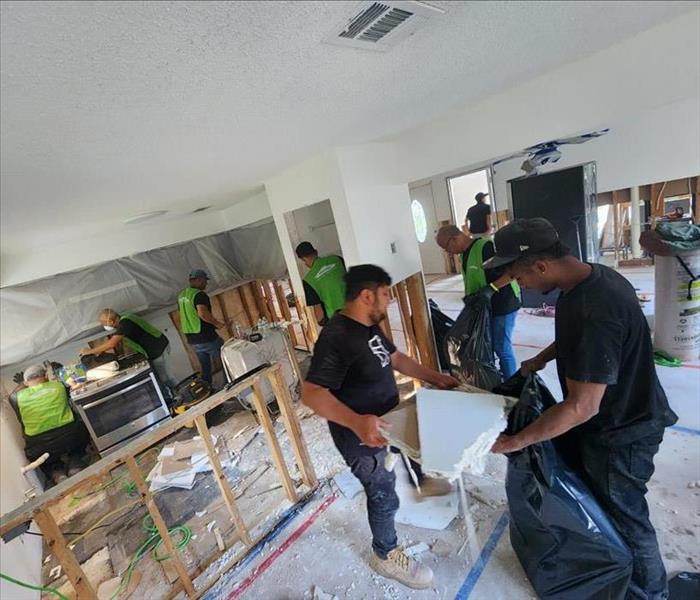 In this blog, we explore the essential steps to restore fire-damaged roofing and gutters, highlighting the importance of professional restoration.
In this blog, we explore the essential steps to restore fire-damaged roofing and gutters, highlighting the importance of professional restoration.
After a fire incident, the damage to your home extends beyond the structure itself. Fires can cause significant harm to your roofing and gutters, compromising their integrity and functionality. Restoring fire-damaged roofing and gutters is a crucial step in the fire-damage restoration process. In this blog, we will explore the essential steps to restore fire-damaged roofing and gutters, highlighting the importance of professional fire damage restoration services, such as those provided by SERVPRO®, in ensuring a thorough and successful remediation.
Safety First: Assessing the Damage
Before any restoration work can begin, it is vital to ensure the safety of yourself and others. Carefully assess the fire-damaged roof and gutters, looking out for structural instability, loose or hanging debris, and the presence of any live electrical wires. If you suspect the integrity of the roof or gutters has been compromised, it is crucial to contact a professional fire damage restoration service immediately to handle the situation safely.
Engage Professional Fire Damage Restoration Services
Restoring fire-damaged roofing and gutters is a complex and potentially dangerous task. Engaging the services of a professional fire damage restoration company, such as SERVPRO, ensures that the restoration process is carried out by trained technicians with the necessary expertise, equipment, and knowledge to address the unique challenges of fire-damaged roofing and gutters. Professional restoration services can also mitigate further damage and provide a comprehensive approach to restoring your home.
Secure and Protect the Area
To prevent additional damage, the fire damage restoration team will secure the fire-damaged roof and gutters. This may involve boarding up or tarping damaged areas, stabilizing any weakened structures, and protecting the surrounding property from potential moisture intrusion caused by the restoration process or inclement weather conditions.
Assess and Repair the Roof Structure
Restoring a fire-damaged roof often involves a thorough inspection of the structural elements beneath the surface. Trained technicians will assess the integrity of the roof deck, trusses, rafters, and other supporting components. Any compromised sections will be repaired or replaced to ensure the stability and longevity of the roof. Repairing the underlying structure is vital before addressing the cosmetic and functional aspects of the roof.
Clean and Remove Soot and Smoke Damage
Fire incidents lead to the accumulation of soot, smoke particles, and residue on the roof and gutter surfaces. These contaminants not only detract from the overall appearance but can also cause long-term damage if left unaddressed. Professional fire damage restoration services utilize specialized techniques and cleaning agents to safely and effectively remove soot and smoke residue from the roofing and gutter surfaces without causing further damage.
Repair or Replace Fire-Damaged Gutters
Fire-damaged gutters may require repair or replacement, depending on the severity of the damage. Trained technicians will carefully inspect the gutters, assessing their structural integrity, functionality, and overall condition. If necessary, damaged sections or entire gutter systems will be replaced to ensure proper drainage and prevent water damage to the property.
Apply Protective Coatings
To enhance the fire resistance and longevity of your restored roof, professionals may apply protective coatings. These coatings not only provide a barrier against potential fire damage but also offer additional benefits such as improved thermal performance, enhanced waterproofing, and increased resistance to UV radiation.
Restoring fire-damaged roofing and gutters requires professional expertise, advanced techniques, and specialized equipment. Engaging the services of a reputable fire damage restoration company, such as SERVPRO, ensures a thorough and efficient restoration process. From assessing the damage and engaging in necessary repairs to cleaning soot and smoke residue and applying protective coatings, professional restoration services can restore the functionality, safety, and aesthetic appeal of your roofing and gutter systems. If you have experienced fire damage to your roof and gutters, contact a professional fire damage restoration team promptly to minimize further damage and ensure a successful restoration.
Dehumidifiers and Mold Prevention: What You Need to Know
3/13/2024 (Permalink)
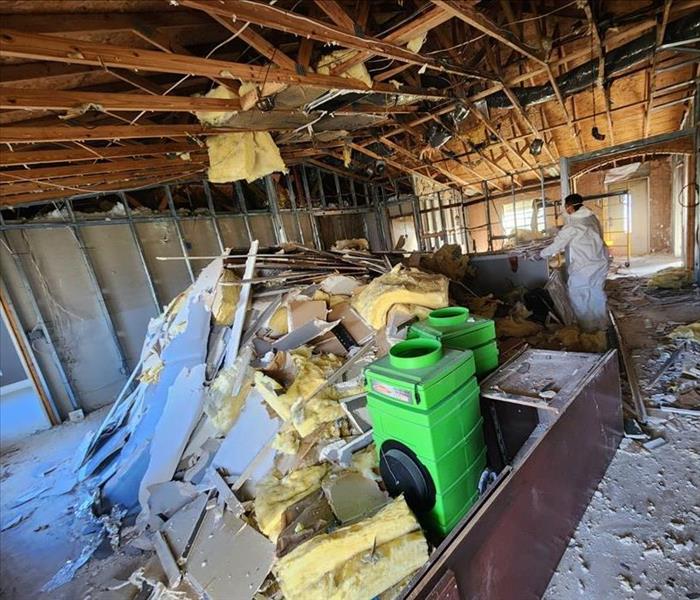 In this blog, we will explore the role of dehumidifiers in mold prevention and provide essential information on using dehumidifiers to combat mold.
In this blog, we will explore the role of dehumidifiers in mold prevention and provide essential information on using dehumidifiers to combat mold.
Moisture control is crucial in preventing mold growth in your home. One effective tool for maintaining optimal humidity levels is a dehumidifier. In this blog, we will explore the role of dehumidifiers in mold prevention and provide essential information on using dehumidifiers to combat mold.
Understanding Dehumidifiers for Mold Prevention
Dehumidifiers are devices designed to reduce and maintain humidity levels in indoor spaces. They extract excess moisture from the air, helping to create a drier environment that is less conducive to mold growth.
Here are some key benefits of using dehumidifiers for mold prevention:
- Moisture Reduction: Mold requires moisture to grow, and high humidity levels can create an ideal environment for mold spores to thrive. Dehumidifiers help control humidity levels, keeping them below 50 percent, which inhibits mold growth.
- Prevention in High-Moisture Areas: Damp areas such as basements, bathrooms, and laundry rooms are prone to mold growth due to increased moisture. By using dehumidifiers in these areas, you can effectively manage humidity levels and reduce the risk of mold infestation.
- Protection for Vulnerable Items: High humidity can damage sensitive belongings like books, photographs, and wooden furniture. Dehumidifiers help protect these items by removing excess moisture from the air, preventing mold growth and preserving their condition.
Choosing the Right Dehumidifier
When selecting a dehumidifier for mold prevention, consider the size of your space, the humidity levels, and the extent of the moisture problem. Here are some key factors to keep in mind:
- Capacity: Consider the pint capacity, which refers to the amount of moisture a dehumidifier can remove from the air in 24 hours. Larger spaces or areas with high humidity will require a higher capacity dehumidifier to effectively manage moisture levels.
- Portability and Placement: Choose a dehumidifier that can be easily moved and positioned in different areas of your home. Portable units with caster wheels or handles offer convenience and flexibility.
- Noise Level: If you plan to use the dehumidifier in a living area or bedroom, consider the noise level. Look for models specifically designed to operate quietly, ensuring minimal disturbance to your daily activities.
- Energy Efficiency: Energy-efficient dehumidifiers consume less electricity, helping you save on your energy bills. Look for models with ENERGY STAR certification, which indicates optimal energy efficiency.
Complementary Mold Prevention Measures
While dehumidifiers play a vital role in mold prevention, they are most effective when combined with other preventive measures. Here are some additional steps to enhance mold prevention efforts:
- Ventilation: Proper ventilation reduces humidity levels, allowing moisture to escape your home. Ensure adequate ventilation in bathrooms, kitchens, and laundry areas to expel excess moisture.
- Fix Leaks and Moisture Sources: Promptly repair any leaks, plumbing issues, or roof leaks to eliminate ongoing sources of moisture.
- Use Exhaust Fans: Install and use exhaust fans in bathrooms and kitchens to remove excess moisture generated during activities like showering or cooking.
- Insulate and Seal: Properly insulate and seal windows, doors, and other areas where condensation can occur, preventing moisture buildup.
Dehumidifiers are effective tools in mold prevention, helping to maintain optimal humidity levels and create an environment that is unfavorable for mold growth. When selecting a dehumidifier, consider your specific needs and choose a model that suits the size and moisture levels of your space. Remember, using a dehumidifier is only one part of a comprehensive mold prevention strategy, and it is important to address any underlying moisture issues and implement additional preventive measures.
For professional assistance with mold prevention, remediation, and restoration, consider contacting experts such as SERVPRO® who specialize in mold restoration services. Their knowledge and expertise ensure that your home is protected from mold and its potential damage, providing you with a safe and healthy living environment.





 24/7 Emergency Service
24/7 Emergency Service
